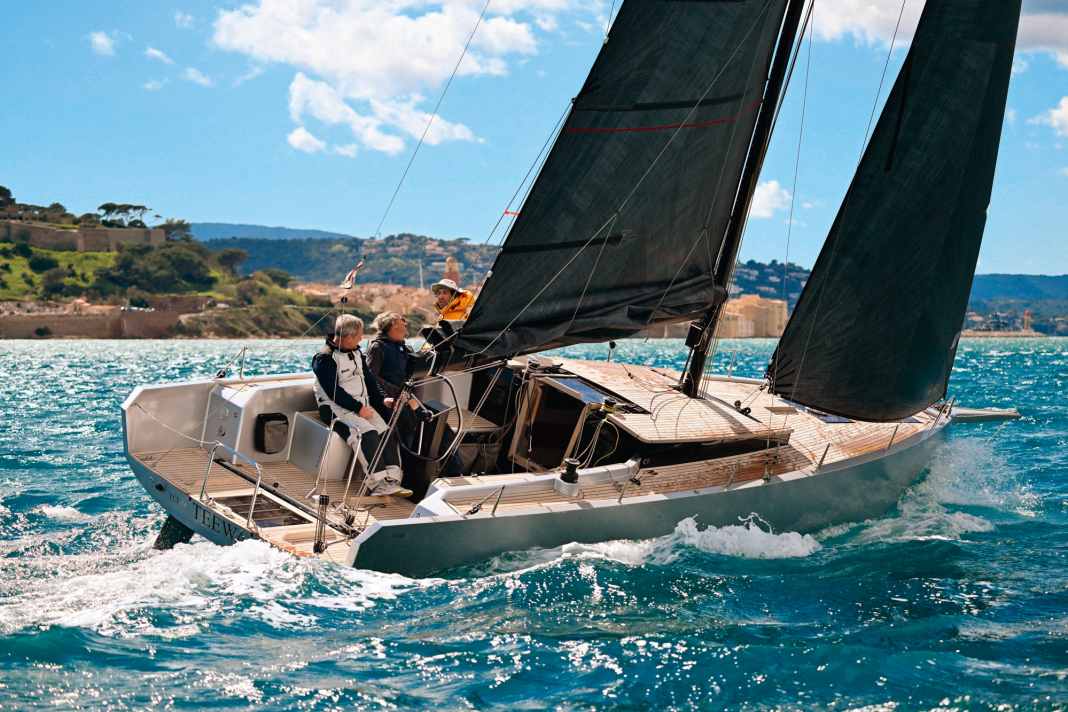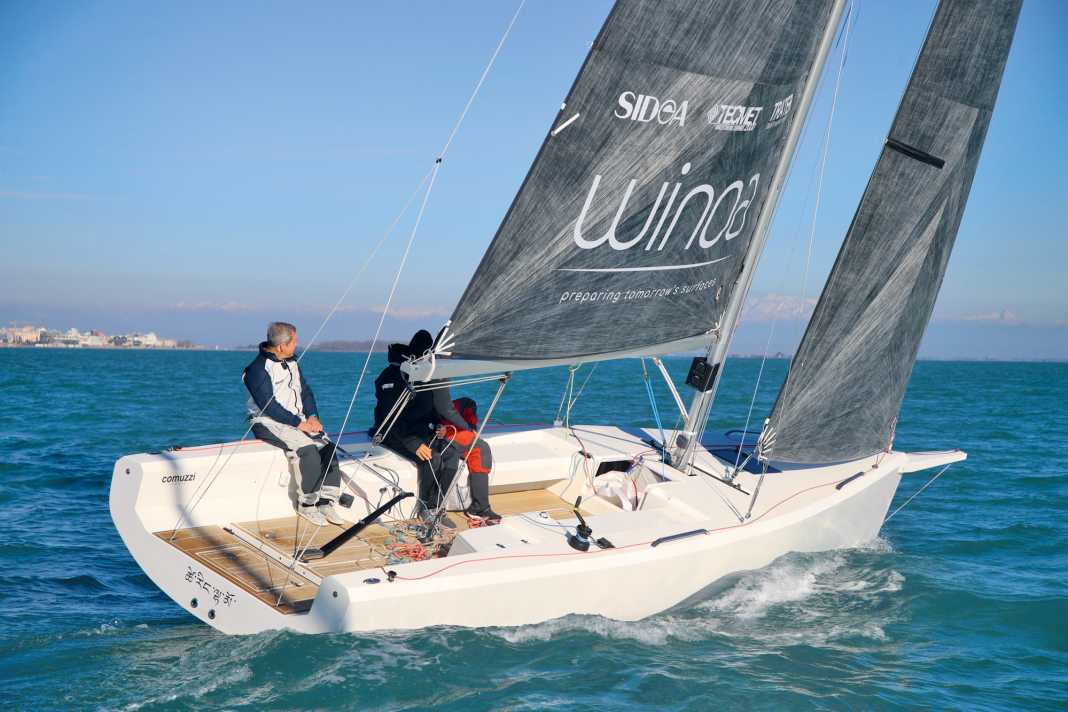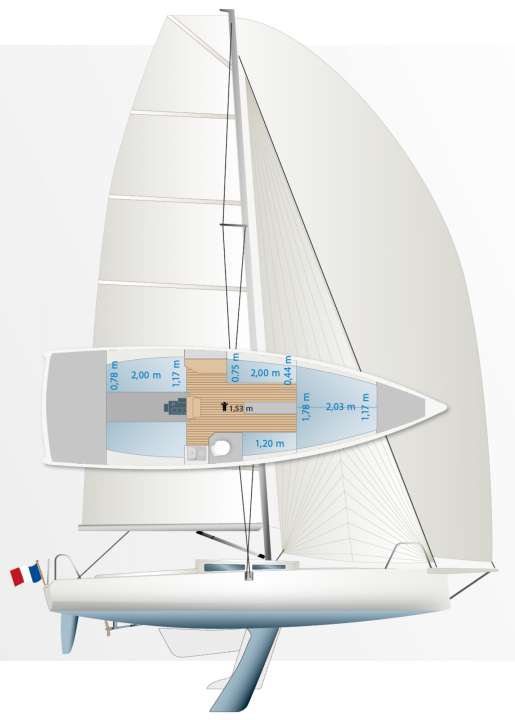





When Frenchman Michel De Franssu announced his first new build project of the Code 0 type under the new Black Pepper Yachts label a good twelve years ago, not many people initially believed the project would be a success. "Pretty, but far too expensive" or "it doesn't stand a chance on the market" were the scathing comments from supposed industry experts at the time. In the end, they were proved wrong.
Black Pepper Yachts has grown from an exotic small business to an internationally recognised yacht building company in the short time since it was founded. Not only have around 30 units of the Code 0 model (YACHT 20/2012 test) already been built, but the shipyard has also rapidly expanded its product line over the last ten years. The Code 0 model with a hull length of ten metres was followed by the larger models Code 1 (13.60 metres), Code 2 (19.70 metres) and the flagship Code 3 (25.10 metres). The brand became known above all for the construction of its yachts made entirely of carbon fibre and their extremely performance-oriented focus.
Also interesting:
Black Pepper has also expanded its programme downwards. The smallest model under the name Code # was presented in the YACHT test as a trailerable sports boat in issue 14/2017. What's more, the carbon specialists based in Nantes on the French west coast have now built no fewer than five Imoca 60 ocean racing yachts and are currently working on the completion of a powerful 21-metre performance catamaran (Code C.69) as a new competitor to Gunboat or Outremer. So there is a lot going on at Black Pepper.
The shipyard has now given its debut model, the Code 0, a thorough overhaul. What's more, although Black Pepper is sticking to the proven concept DNA with the Code 0.1, it is presenting a completely new boat and is also changing design partners. While the plans for the predecessor model came from Naval architect Romaric Neyhousser, the studio of Marc Lombard Yacht Design is now responsible for the design of the new model. In comparison, the boat is hardly any longer, but is significantly wider and has become noticeably fuller, especially in the foredeck area. The rig is now further aft and the stern remains open at the level of the cockpit floor. The French at Black Pepper call this the "Sun Deck".
The Black Pepper Code 0.1 is mainly ordered with a swivelling keel
What has remained, however, is the standardised look of all Black Pepper monohulls. Typical and characteristic of this is the short, flat and angular cabin superstructure in the style of classic yachts à la William Fife or Nathanael Herreshoff. Together with the negative stern and the slightly negative deck step, it gives the boat an unmistakable look. There's no doubt about it: the Code 0.1 is a real eye-catcher.
The swivelling keel is also one of the brand's typical features, even if the rotating fin is actually only an alternative option. As standard, the Code 0.1 is built with an L-shaped fixed keel and ballast bomb, just like the test boat. However, the boat is mainly ordered with a swing keel, especially for use in tidal waters. For this, however, the buyer has to dig deep into their pockets: the hydraulically retractable keel costs an additional 27,000 euros. In this case, the rudder blades are also shorter than standard. With a draught of at least 1.00 metres, the boat can be driven right up to the beach and, according to the shipyard, falling dry should also be no problem with the keel raised.
The conditions off St. Tropez on the Côte d'Azur could not have been better for the test with the Code 0.1. Sunshine, a Mistral with a solid 5 Beaufort (16 to 20 knots of wind) and only a few waves with an offshore wind in the bay - the perfect conditions for a powerful boat like the Code 0.1. The data is correspondingly good: 7.0 knots hard upwind on a true angle of just 40 degrees. This corresponds to a windward speed of just under 5.4 knots VMG (velocity made good), which is already in the performance range of real racers of similar hull length. The boat's enormous rigidity is astonishing. Even in crisp gusts, the Code 0.1 sails upright and accelerates rather than heeling. However, in order to utilise the comparatively large sail area as efficiently as possible, the first reef was used for the test.
On the wind like a dinghy, lively and very direct
The large gennaker is still the good and sensible choice for the downwind leg. The sail area of over 100 square metres immediately pulls the lightweight into planing speed with brute acceleration. It immediately reaches over ten knots, with the best performance of the day being over 13.5 knots in around 20 knots of wind. At the same time, the Frenchwoman shows no difficulty in remaining stable on course. As if on rails, she can be kept on the windward edge as if on rails - a dream to steer! And surprisingly, the unusual wheel steering, which is only installed on the test boat at the customer's special request, also works very well. The boat will be fitted with a tiller from the shipyard.
The modern upwind sail plan provides for a self-tacking jib. Because the mast is positioned quite far aft, the J dimension remains relatively long and the foresail triangle therefore reasonably large. An overlapping genoa with 3D hoisting points on the cabin superstructure is also possible for use on low-wind lakes. The shipyard also offers an even higher inland rig. However, as the sail carrying capacity (ratio of sail area to total weight) is already well above average in the standard version with a value of 6.1, this upgrade does not seem to make much sense.
Beautiful, slim and fast. This is the competition





Black Pepper has the hulls and decks of its Code 0.1 yachts built by carbon specialist Pauger Composites in Hungary, without exception with carbon fibre and epoxy resin, as sandwich constructions with a foam core and using the vacuum infusion process. You can hardly build a better, lighter and more robust boat. The components are then delivered to the shipyard in Nantes for fitting out and completion.
The customer is responsible for the expansion
The equipment on deck is impeccable and of high quality, with fittings and add-on parts from the higher ranges. The very low railing as on the test boat is an option and does not offer much safety or a good place to hold on.
Instead, the deep wire turns out to be a dangerous tripping hazard when getting in and out over the side. The sea fence is therefore not included in the basic equipment. With or without a railing, the Code 0.1 is still categorised as CE design category B.
The customer is responsible for the design. Although there is a standard layout as shown in the crack drawing above, there are many possible variants. Black Pepper wants to be able to fulfil all customer wishes within the scope of feasibility. The owner of the test boat only wants to use his Code 0.1 as a daysailer and occasionally for a club regatta. That's why he only wanted the bare essentials for the interior fittings and also wanted to do without any cruising amenities such as a toilet or kitchen. In this case, the interior remains a very sober and not very cosy living atmosphere. At boot in Düsseldorf, the Code 0.1 was also on display in a version with a more extensive, nicer and significantly more cosy interior.
The independence and quality justify the upmarket pricing policy - at least to some extent
The joy of the coherent concept, the high-quality construction, the excellent equipment and, above all, the great sailing performance with plenty of speed, height and excellent controllability are ultimately spoilt by the steep price. Buyers have to fork out a good 320,000 euros for the standard version of the boat with a built-in engine and carbon rig.
Even compared to the competition, that's a lot of money for a boat with a hull length of just ten metres. What's more, as is usual with performance boats, the sails are not included. For a complete set of sails comprising main, jib, code zero and gennaker, an additional minimum of 45,000 euros is due. The Code 0.1 is not a boat for everyone and certainly not for every budget.
But: The boat is a stunner under sail and its stunning appearance will attract attention both underway and in the harbour. The allure of something special remains tempting.
The measured values for testing the Black Pepper Code 0.1



The Black Pepper Code 0.1 in detail

Technical data of the Black Pepper Code 0.1
- Designer: Marc Lombard
- CE design category: B
- Torso length: 10,05 m
- Total length: 11,10 m
- Waterline length: 9,95 m
- Width: 3,00 m
- Draught (Std. fixed keel): 1,80 m
- Draught. (swivelling keel): 1,00-2,38 m
- Theoretical torso speed: 7.7 kn
- Weight: 2,4 t
- Ballast/proportion: 0,9 t /38 %
- Mainsail: 41,0 m²
- Self-tacking jib: 26,0 m²
- Motor (Nanni): 10.3 kW/14 hp
- Fuel tank: 35 l
- Fresh water tanks: 60 l
- Holding tank: 35 l
Hull and deck construction
Carbon fibre sandwich constructions, built with epoxy and foam core using the vacuum infusion process
Equipment, price and shipyard
Rig and sail
The rig comes from Pauger Carbon Composites in Hungary and is fitted with rod shrouds. The sails are not included in the scope of delivery, the complete wardrobe with laminate (main, jib), plus code zero and gennaker costs from around 45,000 euros extra (gross) depending on quality and manufacturer
Motorisation
Two-cylinder built-in diesel engine from Nanni with shaft drive, optionally also with Saildrive. An electric motor (pod drive) from Torqueedo with battery bank and charger is available as an alternative. The surcharge: 21,400 euros gross
Prices
- Base price ex shipyard: 321.300 €
- Price ready to sail: 379.010 €
- Comfort price: 389.300 €
- Guarantee (incl. osmosis): 1 year
As of 06/24. How the prices shown are defined can be found here!
Shipyard and distribution
Black Pepper Yachts, 44100 Nantes (France); www.blackpepper.fr
YACHT review of the Black Pepper Code 0.1
Pretty, highly versatile daysailer or weekender with high performance potential for successful regatta use. Best basic equipment ex shipyard
Design and concept
- + Consistent lightweight construction
- + Visually very attractive
- -Very high price in comparison
Sailing performance and trim
- + Extremely high performance potential
- + Clear handling
- + Reactive on the rudder
Living and finishing quality
- + High degree of versatility in the extension
- + Touring suitability in modules
- - Sober and uncomfortable inside
Equipment and technology
- + Variable draught possible
- + Modern, high-performance rig
- - Sea fence too low

